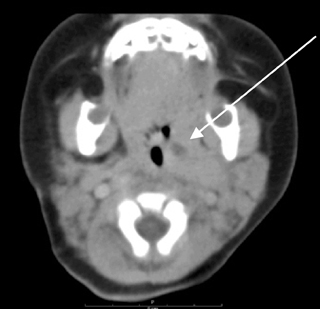Yonsei Med J.
2006 Aug;47(4):568-570. 10.3349/ymj.2006.47.4.568.
Peritonsillar Abscess in a 40-Day-Old Infant
- Affiliations
-
- 1Department of Pediatrics and Institute of Allergy, Yonsei University College of Medicine, Seoul, Korea. kekim@yumc.yonsei.ac.kr
- 2Department of Radiology, Yonsei University College of Medicine, Seoul, Korea.
- 3The Brain Korea 21 Project for Medical Science, Seoul, Korea.
- KMID: 1779508
- DOI: http://doi.org/10.3349/ymj.2006.47.4.568
Abstract
- A peritonsillar abscess is one of the most commonly occurring deep space infections of the head and neck in adults and children. A peritonsillar abscess that appears in newborns, however, is extremely rare. The treatment of a peritonsillar abscess requires both the selection of appropriate antibiotics and the best procedure to remove the abscessed material. We report a case of a peritonsillar abscess in a 40-day-old infant who was treated with antibiotic therapy alone.
Keyword
MeSH Terms
Figure
Cited by 1 articles
-
Deep Neck Abscesses in Children and Adolescents: 10 Year Experience in Two General Hospitals
Eunhee Kim, Ju Hee Jeon, Won Uk Lee, So Young Kim, Eun Ryoung Kim
Korean J Pediatr Infect Dis. 2011;18(2):163-172. doi: 10.14776/kjpid.2011.18.2.163.
Reference
-
1. Schraff S, McGinn JD, Derkay CS. Peritonsillar abscess in children: a 10-year review of diagnosis and management. Int J Pediatr Otorhinolaryngol. 2001. 57:213–218.2. Suzuki M, Ueyama T, Mogi G. Immediate tonsillectomy for peritonsillar abscess. Auris Nasus Larynx. 1999. 26:299–304.3. Akhtar MJ, Shinefield HR. Staphylococcus aureus peritonsillar abscess in an 11-week old infant. J Laryngol Otol. 1996. 110:78–80.4. Brondbo K, Hoie T, Aalokken M. Peritonsillar abscess in a 2 1/2-month-old infant. J Otolaryngol. 2000. 29:119–120.5. Herzon FS, Harris P. Mosher Award thesis. Peritonsillar abscess: incidence, current management practices, and a proposal for treatment guidelines. Laryngoscope. 1995. 105:Suppl 74. 1–17.6. Kim SJ. Bacteriologic characteristics and serotypings of streptococcus pyogens isolated from throats of school children. Yonsei Med J. 2000. 41:56–60.7. Steyer TE. Peritonsillar abscess: diagnosis and treatment. Am Fam Physician. 2002. 65:93–96.8. Parker GS, Tami TA. The management of peritonsillar abscess in the 90s: an update. Am J Otolaryngol. 1992. 13:284–288.9. Yano J, Okita W. Peritonsillar abscess-a comparison of treatment by needle aspiration and incision. Nippon Jibiinkoka Gakkai Kaiho. 1993. 96:219–224.10. Wolf M, Even-Chen I, Kronenberg J. Peritonsillar abscess: repeated needle aspiration versus incision and drainage. Ann Otol Rhinol Laryngol. 1994. 103:554–557.
- Full Text Links
- Actions
-
Cited
- CITED
-
- Close
- Share
- Similar articles
-
- Two Cases of Peritonsillar Abscess Following Tonsillectomy
- Diagnosis of Peritonsillar Abscess Using Gray Scale Image and Color DopplerImage of Intraoral Ultrasonography
- Characteristics of Microbiology of Peritonsillar Abscess
- Peritonsillar Involvement in Pyoderma Gangrenosum associated with Ulcerative Colitis
- A Case of Internal Carotid Artery Aneurysm Mimicking Peritonsillar Abscess



